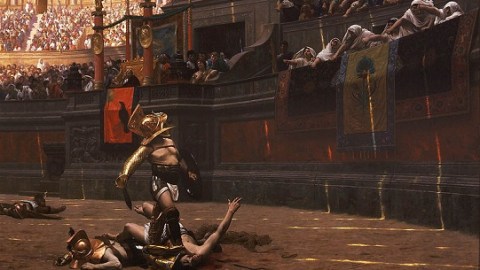Thumbs Up: Reconsidering Jean-Léon Gérôme

If you think that a thumbs up in ancient Rome meant that the beaten gladiator would live and that a thumbs down meant death, you can thank Jean-Léon Gérôme’s 1872 painting Pollice Verso (shown above) for that. In reality, thumbs down meant “stick your sword in the ground” and no kill. Thumbs up meant “stick the sword in his neck.” It’s amazing to think of how a single work could generate such a widespread idea, but Gérôme enjoyed that kind of influence in the nineteenth century thanks to hi show-stopping scenes of the ancient world and exotic east. As tastes shifted towards modernism with the turn of the twentieth century, Gérôme slid into obscurity. Reconsidering Gérôme, edited by Scott Allan and Mary Morton, accompanies The Getty Center’s exhibition, The Spectacular Art of Gérôme, in trying to restore Gérôme’s good name in today’s art world. Their efforts amount to one big thumbs up for an artist whose old-fashioned realism masks modernist impulses that make Gérôme’s art relevant today.
Although Gérôme rose to the heights of French art during his lifetime, he still had his critics, who decried his genre painting as paling before the grand history painting in the manner of Jacques-Louis David and others. Gérôme built an international reputation with the help of his father-in-law Adolphe Goupil, who mass-marketed his son-in-law’s work through reproductions. That international fame drew students to Paris to study with Gérôme and carry on his ideas.
“Coming at a time of ferment in Gérôme studies, when a predominantly younger generation of scholars is busy discovering the artist and approaching his work with refreshing seriousness and creativity,” Scott Allan writes in his “Introduction,” “the present volume goes a long way in challenging old critical biases as well as laying out productive new avenues of inquiry and research.” This isn’t your father’s or grandfather’s Gérôme, Allan argues. The essays that follow surround the misconceptions that amassed against Gérôme over the years and knock them down without overstating the case or making Gérôme something he wasn’t.
In line with The Spectacular Art of Gérôme, several of the essays focus on the artist of the grand spectacles such as Pollice Verso. “In popular literature, illustration, theater, and film, images of gladiators and Christian martyrs borrowed from Gérôme’s work have helped form the aesthetic vocabulary with which mass culture describes ancient Rome,” writes Emily Beeny in “Blood Spectacle: Gérôme in the Arena.” “The familiar cinematic Rome remains, to some substantial degree, Gérôme’s invention.” Ridley Scott credits seeing a reproduction of Pollice Verso as the inspiration for his film Gladiator. The moral ambiguity of that film emerges in a close reading of the painting as well. For Beeny, Pollice Verso “satisfies our desire to watch a gruesome spectacle even as it subtly chastens us for this very desire. Gérôme positions himself as both purveyor of spectacles… and a critic of the Roman rabble. He makes us hover between the sand and the stands, at once critical and complicit.”
In “Gérôme’s Cinematic Imagination,” Marc Gotlieb continues the film connection and goes even further, seeing “Gérôme as implicated in the rise of mass-market entertainments, thanks to his affiliation with new-media technologies that seemed effortlessly to mix exotic imagery and cultural stereotypes.” Thanks to his use of photography and reproduction, Gérôme becomes a prototype of the modern, almost Warholian artist. This shuttling between the present and near-present to the past makes these essays so fascinating. Gottlieb goes on to call Gérôme a proto-cinematographer, arguing that in paintings such as Pollice Verso “Gérôme [is] forging narrative practices that would take the cinema decades to invent,” specifically “cinema’s so-called omniscient spectator” that sees everywhere at once.
Nina Lubbren, “Crime, Time, and The Death of Caesar,” also makes claims for Gérôme’s modernity. Instead of depicting ancient figures as heroes, such as in The Death of Caesar, “the deployment of inanimate objects as clues [by Gérôme] intimates a modern world emptied of transcendental significance.” In “Groping the Antique: Michelangelo and the Erotics of Tradition,” Allan Doyle looks at Gérôme’s Michelangelo Showing a Student the Belvedere Torso as a bold sexual statement. “Where his contemporaries positioned Michelangelo caught between male and female bodies, Gérôme shows him sandwiched between ephebic immaturity and a mutilated totem of hyperbolic masculinity,” Doyle explains. “Gérôme thereby pictures Michelangelo as being enthralled by the now outmoded paradigm of eroticized male bodies found in the Davidian atelier.” Gérôme thus leaves behind not only David’s grand history painting, but also the sexual politics embedded in that style.
Peter Benson Miller’s essay “Gérôme and Ethnographic Realism at the Salon of 1857” tackles the difficult and important issue of Gérôme’s Orientalism. Ever since Edward Said used Gérôme’s The Snake Charmer on the cover of his 1978 book Orientalism, Gérôme has been a popular whipping boy for ethnographic painting as domineering colonialism of some stripe. Miller rehabilitates Gérôme’s reputation as being much more than exploitation. Mary Roberts’ “Gérôme in Istanbul” also contributes to this conversation, which holds great relevance for us trapped in the Age of Terrorism and the Global Village, in which we avoid or exploit the “other” at our peril and our loss.
Turning around the common technique of comparing artists on friendly terms, Peter Cooke’s “An Artistic Enmity: Gérôme and Moreau” looks at the dynamic of two artists who hated each other. Gustave Moreau’s Salome Dancing Before Herod becomes his response to Gérôme’s Orientalism, in which “[t]o the reportage of Orientalist genre painting, Moreau opposes aesthetic enthrallment, semiotic saturation, and polysemous mystery.” Both influential teachers, Moreau and Gérôme passed on their opposition to their students. Moreau bequeathed “his faith in the transformative power of art in the face of prevailing naturalism” to students such as Henri Matisse and Georges Rouault, whereas Gérôme’s teaching of “unswerving naturalism and insistence on ‘correct’ drawing… offered [his students] an aesthetic dead-end as far as the twentieth-century avant-garde was concerned.” Fortunately, students of Gérôme, such as Thomas Eakins, can share in his reevaluation. In fact, Manly Pursuits: The Sporting Images of Thomas Eakins at the Los Angeles County Museum of Art runs nearby and almost simultaneously with the Gerome show at The Getty Center.
Reconsidering Gerome can serve as a template for a fresh look at an artist once relegated to museum storage rooms. In Gérôme’s case, his art still shapes how we look at the ancient past and, to some degree, the exotic east. Recovering the source of our cultural DNA can help us understand who we are today and where we can and should be going. More than just a exhumation of a buried reputation, Reconsidering Gerome is a salvage operation of a forgotten part of who we are.
[Image: Jean-Léon Gérôme. Pollice Verso, 1872. Oil on canvas, 39.5 x 58.6 cm (15.5 x 23 in.). Phoenix Art Museum. Museum purchase.]
[Many thanks to Getty Publications for providing me with a review copy of Reconsidering Gérôme, edited by Scott Allan and Mary Morton. The Spectacular Art of Gérôme continues at the Getty Center through September 12, 2010.]





